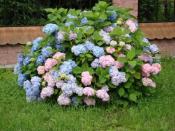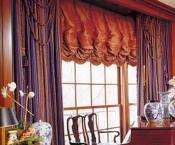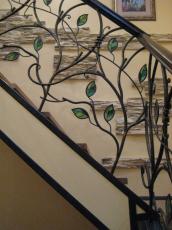Search
Login
Staircase in a country house, handrails and railing for the stairs - what material to make and how to install
An important structural element of a country house is a staircase. Very often, a beautiful staircase becomes a business card at home, will play a major role in the interior and sets the style of the room as a whole.
The main functional purpose of the staircase is the possibility of comfortable movement between the floors of the house. Safety and reliability of the structure is ensured by railings and handrails, on which the general view of the staircase and its strength depend.
Content
- Staircase in a country house: tips for choosing and designing
- Stair railing and filling elements video
- Types of handrails and features of their installation
- DIY manufacture and installation of stair railing
Staircase in a country house: tips for choosing and designing
At the design stage, it is necessary to determine what the staircase should be. It is important to choose the right shape, type and material of manufacture staircase construction, taking into account the general architectural composition of the room.

We list some rules that should be followed when choosing and designing stairs:
-
It is advisable to equip the stairs with platforms every 10 steps, otherwise it will be difficult to climb.
-
The width of the stairs should not be less than 80 cm (two people should freely disperse on the stairs).
-
The step height, comfortable for moving, is about 15-18 cm, and the depth is 25-30 cm.
-
Staircases between floors in width should be greater than (or equal to) the width of the flight of stairs.
-
The angle of inclination of the staircase structure should not be more than 45 degrees (optimally 25-35 degrees).
-
The staircase must be fireproof (wooden structures are treated with a special compound that prevents fire).
-
The less space for the location of the stairs, the steeper the angle of elevation will be, and the design will have more bends and turns.

-
Brick stairs are especially durable. Such stairs are usually installed on the outside.

-
Metal structures (forged, stainless steel) are very stable, but not always harmoniously fit into the interior of the house.
-
A wooden staircase will bring coziness and elegance to the room, but such a design will cost more than the others.
-
In order to avoid creaking while walking, it is necessary to install a staircase made of oak, beech, ash.

-
Good performance in combined staircases (metal + glass, wood + plastic). A competent combination will save space and allow you to create an original staircase.

Stair railing and filling elements
Railings are fences installed along the edge of the staircase. Standard railings consist of handrails (straps that can be relied on when walking) and balusters (wooden bars, metal rods, glass panels and others).
They make a lot of time for the manufacture and installation of handrails, because they ensure the safety of movement on the stairs and play a significant role in the architectural ensemble of the entire structure.

Railings for stairs are made of wood, metal (forged, railings made of steel, aluminum, stainless steel), concrete and plastic.
Consider the most popular types of railings used in the arrangement of stairs in a country house.
Wooden railing
Wooden railings balusters are pillars of square or round cross-section, which can be decorated with milling, carving or veneer of valuable trees. Depending on the designer's idea, handrails can be made from the same material as balusters, or from other wood.

The configuration of the railing will depend on the structure of the staircase itself. If the staircase is spiral, then the railing has a spiral shape.

Railing for the straight flight of stairs.

The handrails of the wooden railing should be smooth, without roughness, chips that could cause injury.
Wooden railings for stairs have several advantages:
- universality of application (suitable for almost any interior);
- give the house a sense of comfort;
- environmental friendliness;
- strength and reliability (when using special processing means they are not subject to darkening, decay and fire).
Metal railing: stainless steel and anodized aluminum
Metal fencing is now at the peak of popularity. This is due to their high performance and ease of installation. Such railings can be combined with stairs made of different materials: concrete, brick, wood or metal.
The advantages of metal railings for stairs can also include:
- do not require updating during the operational period;
- affordability (relative to wooden railing);
- for the manufacture of railings, various materials can be used (simple fittings, pipes and profiles);
- various forms of stair railings.
The metal railing consists of a frame (rack), a handrail and a section of the fence (span with designer elements).
In the manufacture of fences for stairs located on the street, stainless steel is the best solution, which does not corrode and does not need additional care.

Stainless steel railings for stairs can have both polished and matte surfaces.
Anodized aluminum railings are lightweight and easy to install. Aluminum railing is assembled using metal screws and epoxy glue. To maintain the attractive appearance of the railing, it is enough to periodically wipe them with a cloth dampened with any detergent.
The sophistication of metal fences can be achieved by filling decorative spaces between the racks with decorative elements. More economical is the use of cast and stamped decorative elements.

Forgedness will add originality and color to the stairs.
Forged railing
A variety of metal fences are forged railings for stairs. I’m sorry, their main advantage is the possibility of making railings in any style. Art forging makes the staircase the dominant component of any interior.
Forged fences can be installed for stairs located on the street and in the house. They are usually applied anti-corrosion coating, which allows them to maintain their strength and initial appearance for many years.

Forged railings have all the advantages of metal structures, the only drawback is the cost of their manufacture. The price calculation of staircases made by art forging depends on the complexity of the pattern and the size of the decorative elements.
Types of handrails and features of their installation
Any staircase, at least on one side, must have a handrail that you can lean on when walking. There are various options for the manufacture and use of stair handrails.
Classification of handrails at the place of their fastening
According to the method and place of attachment, three types of handrails can be distinguished:
- over a free bowstring;
- handrails with a bearing function;
- handrails over a wall bowstring.

Handrails are attached to balusters using anchors, self-tapping screws or welding (depends on the material from which the handrail and balusters are made).

The handrails are fixed to the wall along the stairs with the help of articulated or molded holders (brackets), wrapping the bar in an arbitrary place or from the end.
Types of handrails in shape and material
Handrails for stairs can be made in various forms. The most common models of handrails are:
- round;
- rectangular;
- oval;
- square;
- rounded
- bent (angular).

Depending on the purpose of the staircase, it is possible to choose the best material for its manufacture.
For the street, it is better to use stainless steel handrails, chrome, forged or aluminum.
Handrails made of polyvinyl chloride (PVC) look like wood, and in their characteristics are similar to metal. The main advantage of such handrails is that they are very plastic (when heated with an industrial hairdryer, you can create any very intricate structure). An important advantage is the low price.

Wooden handrails are still one of the most sought after, thanks to the special atmosphere that natural wood brings to the interior of the house. Some stair handrails made of wood and framed by hand carvings can be called a work of art.

Original Handrail Options
In a small country house or cottage, original handrails from improvised tools will look appropriate.
A deliberately gruff log handrail will become a spectacular design element. For the arrangement you will need: a log, fasteners and hooks-holders.

A little more effort will be needed to create a polycarbonate railing with handrails from branches.

A handrail made of rope or thick rope will fit into the interior of a country house, made in a marine or urban style.

Features of the installation of stair handrails
A free handrail, placed above the free staircase, fixes the flat and bar components of the railing. To install the handrail to the racks, dowels, glue and trunnions are used.
The direction and shape of the free handrail must fully correspond to the shape and direction of the staircase. Therefore, it is desirable to produce such a handrail at the same time as a handrail.
The transition from the rectilinear component of the handrail to the curved, can be performed as an inclined or vertical connection.

With a vertical connection, over time, at the point where the handrail is bent, the joint may slightly diverge (when the stairs settle). An open groove will slightly worsen the appearance of the railing and will interfere with the normal sliding of the hand on the handrail.
When designing a curved staircase, it is better to make a handrail of a simple form, this will facilitate the manufacture of the profile of the handrail.
DIY manufacture and installation of stair railing
Basic Railing Requirements

When making stair rails yourself, it is important to adhere to the general rules for their design:
- the optimal height of the railing on the stairs is 90-100 cm;
- if there are small children in the family, it is advisable to equip additional rails appropriate for the growth of the babies
- the railing surface should be smooth;
- on narrow staircases it is permissible to install a railing on one side, a staircase more than 125 cm wide must be equipped with a railing on both sides;
- the distance between balusters should not exceed 15 cm.
DIY wooden railing installation
Starting to independently manufacture a staircase rail from wood, the question arises: How to make a railing for a staircase? There are two options: to order ready-made handrail elements or to make hand-rails and balusters with your own hands.
In order for the wooden bars to acquire an aesthetic and decorative look, they can be processed on a milling machine.
Consider the step-by-step installation of wooden railings:
-
The extreme pedestals are installed, which serve as the foundation of the structure.
-
On the pedestals you need to fasten the guide lace (along it will be installed entrusted).
-
The distance between balusters is determined and marked.
-
Balusters are attached to steps or bowstrings. The angles of the end surfaces of the baluster from above should correspond to the inclination of the bowstring, and from below should be even and installed at an angle of 90 degrees. You can fix balusters with the help of self-tapping screws mounted on glue.

-
The handrail is attached to the balusters. Difficulties can arise at the joints of transitional parts (when changing the direction of the stairs).
-
The final step is cleaning the finished product. It is necessary to sand the protruding parts, putty the gaps, clean off sawdust and dust. Wipe the entire surface of the baluster handrail with a damp cloth.
The railing can be painted and varnished.
DIY metal railing installation
The installation of handrails made of aluminum, stainless steel and painted pipes is almost the same.

Consider the step-by-step process of installing stainless steel railings on a concrete staircase:
- In the steps of the stairs, holes are drilled for the mounting studs of the racks. The holes must be cleaned of dust (with a vacuum cleaner or compressor).
- The holes are filled with glue and threaded rods are installed in them.
- The nut fixes the mounting angle and the plate to the stud.
- The stand is mounted with a stand screw or welded to the plate. The position of the rack is controlled by level (alignment is strictly vertical at an angle of 90 degrees).
- The handrail is attached to the racks by welding or bolting.
- Welds must be cleaned and sanded (using a turbo grinder).
- Wipe the seams with polishing paste.





